Cardiovascular system
Izvarino Pharma offers a wide range of medicinal products used for the treatment of cardiovascular diseases. The portfolio has been formed on the basis of product commercial success on the Russian market and proven efficacy.
Izvarino Pharma offers a wide range of medicinal products used for the treatment of cardiovascular diseases. The portfolio has been formed on the basis of product commercial success on the Russian market and proven efficacy.
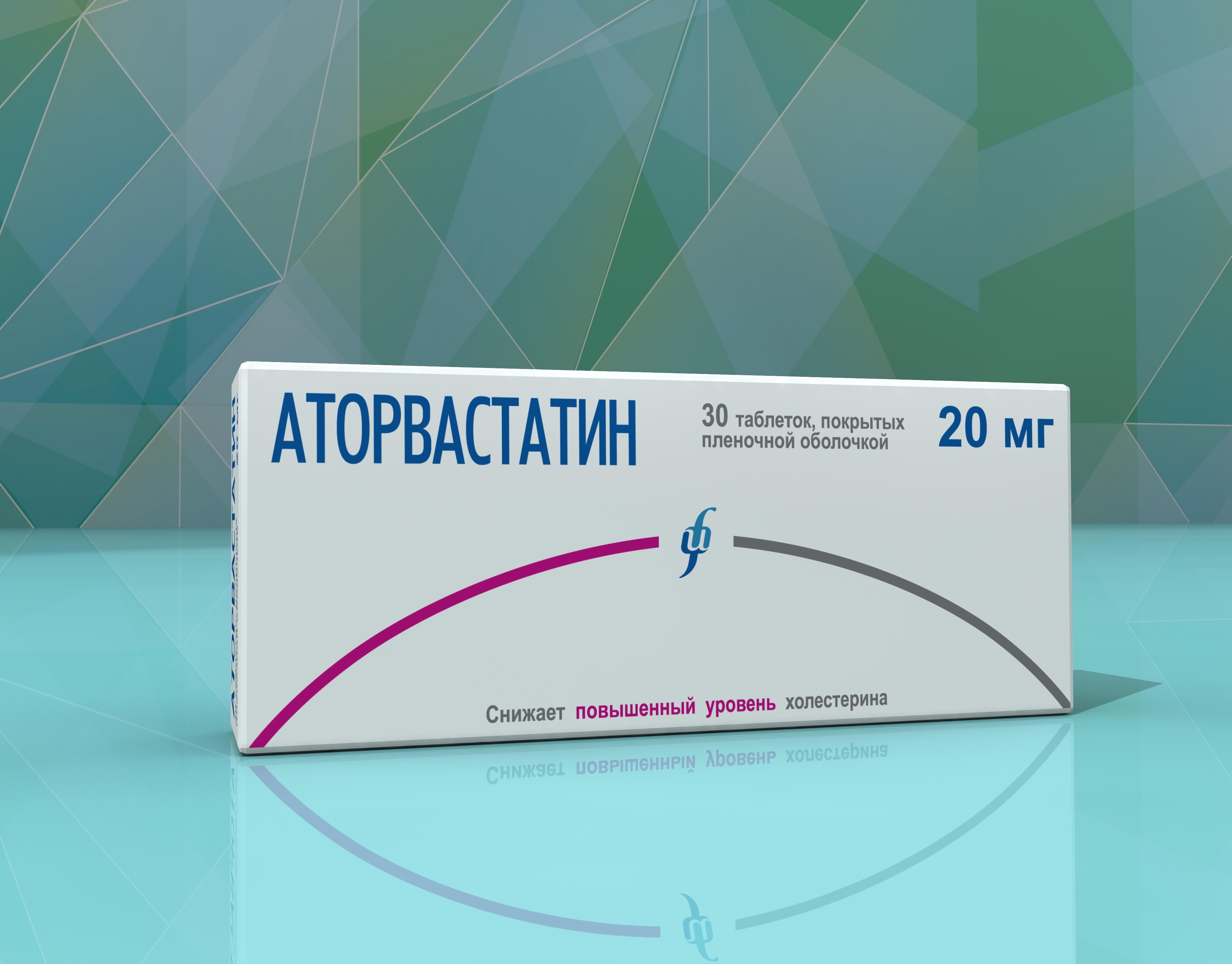
1 film-coated tablet 10 mg contains:
Active ingredient: atorvastatin calcium trihydrate - 10.85 mg equivalent to atorvastatin - 10.00 mg.
1 film-coated tablet 20 mg contains:
Active ingredient: atorvastatin calcium trihydrate - 21.70 mg equivalent to atorvastatin - 20.00 mg.
Film-coated tablets, 10 mg, 20 mg.
10 or 15 tablet in a blister of polyvinyl chloride film and aluminum foil.
2, 3, 4, 6, 9, or 10 blisters with patient leaflets are placed in a carton pack.
Hypercholesterolemia:
• as an adjunct to diet to reduce total cholesterol, LDL-C, apo B and triglycerides high levels in adults, adolescents and children of 10 years of age and more with primary hypercholesterolemia, including familial hypercholesterolemia (heterozygous) or combined (mixed) hyperlipidemia (Frederickson Type IIa and Type IIb respectively) where response to diet and other non-drug treatment methods is insufficient;
• to reduce total cholesterol, LDL-C in adult patients with homozygous familial hypercholesterolemia as an adjunct to other hypolipidemic treatments (such as LDL apheresis) or where such treatments are not available.
Prevention of Cardiovascular Disease:
• prevention of cardiovascular events in adult patients at high risk of primary cardiovascular events as an adjunct to other risk factors management.
• secondary prevention of cardiovascular complications in patients with CHD in order to reduce mortality, myocardial infarction, strokes, repeated hospitalizations for angina pectoris and the need for revascularization.
Oral. Take at any time of the day with or without food.
Treatment with atorvastatin should be started after an attempt to achieve hypercholesterolemia control with a diet, physical exercise, weight control and treatment of main disease.
Prior to administration patients should be placed on a standard cholesterol-lowering diet to be continued during the entire period of treatment with atorvastatin.
The dose ranges between 10 mg and 80 mg once daily and is titrated according to LDL-C concentrations, goal of therapy and individual response to the therapy.
The maximum daily dose is 80 mg.
After initiation and/or upon titration of atorvastatin
lipid blood concentrations should be analyzed within 2-4 weeks and dosage adjusted accordingly.
Primary hypercholesterolemia and combined (mixed) hyperlipidemia
For most patients the recommended dose of atorvastatin is 10 mg once daily; therapeutic response is evident within 2 weeks, and the maximum response is usually achieved in 4 weeks. The response is maintained during chronic therapy.
Homozygous familial hypercholesterolemia
In most cases the administered dose is 80 mg once daily (18-45% reduction of
LDL-C).
Heterozygous familial hypercholesterolemia
The initial daily dose is 10 mg. Doses should be individualized, and adjustments should be made at intervals of 4 weeks or more with possible titration up to 40 mg daily. Then the dose can be either increased to the maximum 80 mg daily or bile acid sequestrants can be combined with 40 mg atorvastatin daily dose.
Prevention of Cardiovascular Disease
In the studies of primary prophylaxis, atorvastatin daily dose was 10 mg A dose increase may be needed to achieve LDL-C concentrations as per modern recommendations.
Usage in pediatric patients aged between 10 and 18 with heterozygous familial hypercholesterolemia The recommended initial dose is 10 mg once daily. The dose may be increased to 20 mg daily according to the clinical response. Doses greater than 20 mg (equivalent to 0.5 mg/kg) are limited.
Doses should be titrated according to the goal of lipid-lowering therapy. Adjustments should be made at intervals of 4 weeks or more.
Hepatic Impairment
In hepatic impairment the dose of atorvastatin should be reduced subject to regular controls of liver transaminase: aspartate aminotransferase (AST) and alanine aminotransferase (ALT).
Renal Impairment
Renal impairment does not affect atorvastatin concentrations in plasma or LDL-C lowering efficacy, that is why no dose adjustment is needed.
Geriatric patients
There were no differences in safety and effectiveness of atorvastatin in elderly patients compared to general population; no dose adjustment is needed. (see section ‘Pharmacokinetics’).
Drug Interactions
In concomitant administration with cyclosporine, telaprevir or tipranavir/ritonavir combination, the daily dose of atorvastatin should not be greater than 10 mg (see section ‘Warning and Precautions’).
Precautions should be taken and the lowest efficient dose of atorvastatin should be used in concomitant administration with HIV protease inhibitors, hepatitis C protease inhibitors (boceprevir), clarithromycin and itraconazole.
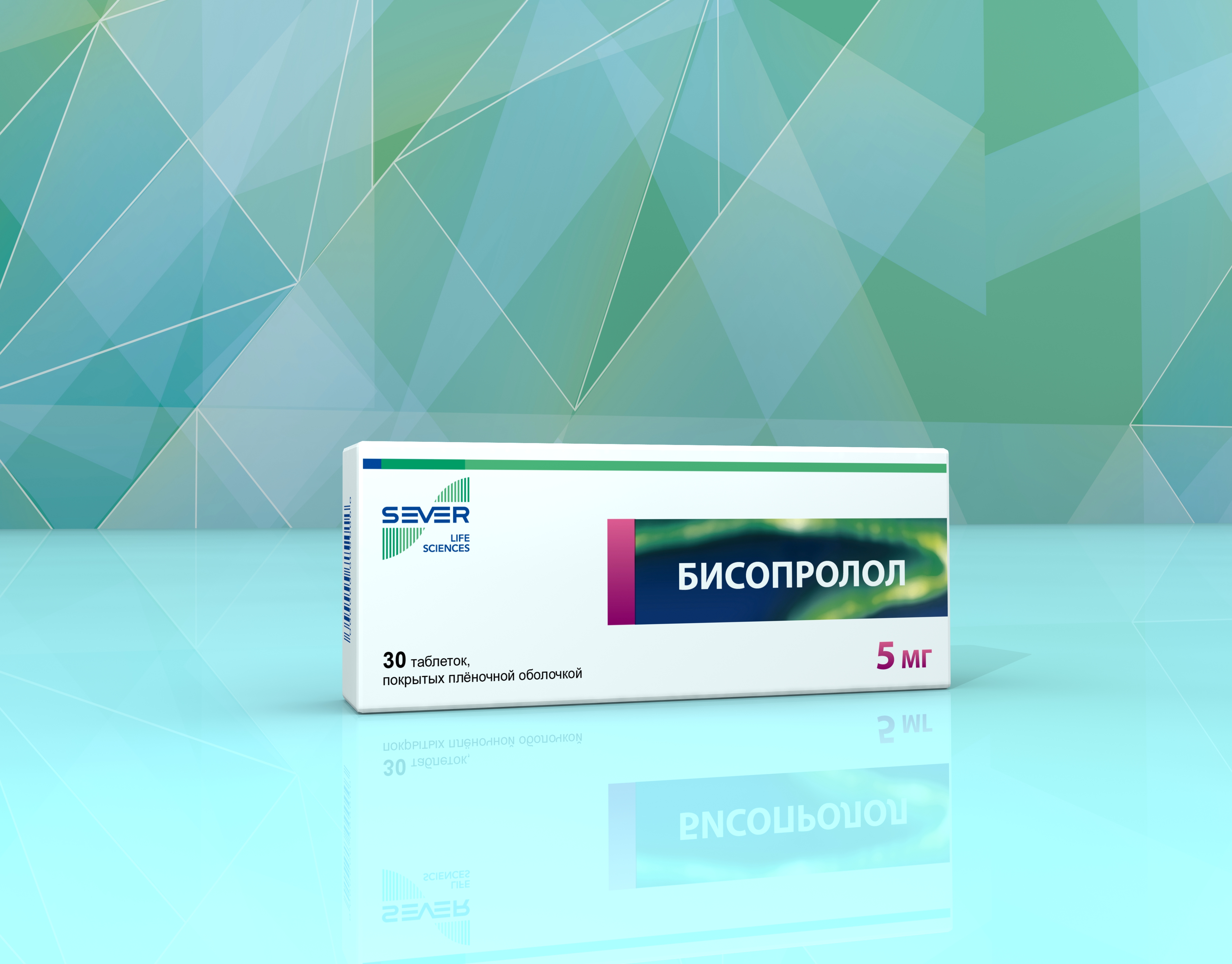
1 film-coated tablet 5 mg contains:
Active ingredient: bisoprolol fumarate - 5.00 mg.
1 film-coated tablet 10 mg contains:
Active ingredient: bisoprolol fumarate - 10.00 mg.
Film-coated tablets, 5 mg, 10 mg.
10 or 15 tablets in a blister of PVC film and aluminum printed glazed foil.
1, 2, 3, 5, 6, 9, or 10 blisters with patient leaflets are placed in a carton pack.
• arterial hypertension;
• coronary heart disease: stable angina;
• chronic heart failure.
Oral, before morning meal, without chewing, as a single dose.
Arterial Hypertension and Stable Angina
In all cases the treatment must be individualized to the patient by the physician, in particular, the heart rate and condition of the patient should be taken into account.
The initial dose is 5 mg once daily. Where necessary the dose may be increased to
10 mg once daily. The maximum daily dose is 20 mg.
Chronic Heart Failure
The standard CHF therapy includes angiotensin-converting enzyme inhibitors (ACE) or angiotensin II receptor antagonists (where ACE inhibitors are not tolerated), β-blockers, diuretics and, optionally, cardiac glycoside. The initial treatment of CHF must include a special phase of titration and regular medical supervision.
A prerequisite for treatment is stable CHF without signs of exacerbation.
Treatment of chronic heart failure should be started in accordance with the following titration scheme. In this case, individual adaptation may be required depending on patient tolerates of the selected dose, i.e. the dose can be increased only if the previous one was well tolerated.
Week 1 - 1.25 mg* once daily
Week 2 - 2.5 mg once daily
Week 3 -3.75 mg once daily
Week 4-7 - 5 mg once daily
Week 8-11 - 7.5 mg once daily
Week 12 and later - 10 mg once daily as maintenance treatment.
*In this titration scheme bisoprolol of other manufacturers should be used in the form and dosage to make the dose of 1.25 mg (for example,½ tablet 2.5 mg).
The maximum recommended dose of Bisoprolol is 10 mg once daily. BP, heart rate and severity of CHF symptoms should be regularly monitored during titration. If the maximum recommended dose is not tolerated, gradual dose reduction should be considered.
During the titration phase or after it, a temporary deterioration in the course of heart failure, arterial hypotension, or bradycardia may occur. In this case, concomitant therapy should be adjusted first of all. If this measure shows no effect, Bisoprolol dose should be temporarily reduced or stopped.
The treatment should be either re-titrated or continued after patient condition stabilizes.
Special Populations
Renal and Hepatic Impairment
In mild or moderate renal or hepatic impairment dose adjustment is not generally required. In severe renal impairment (CC below 20 ml/min) and in patients with severe liver disease the maximum daily dose is
10 mg. In this populations doses should be titrated with caution.
In elderly patients dose adjustment is not required.
To date, there is insufficient data on the use of bisoprolol in patients with heart failure in combination with type 1 diabetes mellitus, severe renal and/or liver dysfunction, restrictive cardiomyopathy, congenital heart defects or heart valve disease with severe hemodynamic disorders. Also, until now, there are no sufficient data on heart failure patients who had myocardial infarction over the past 3 months.
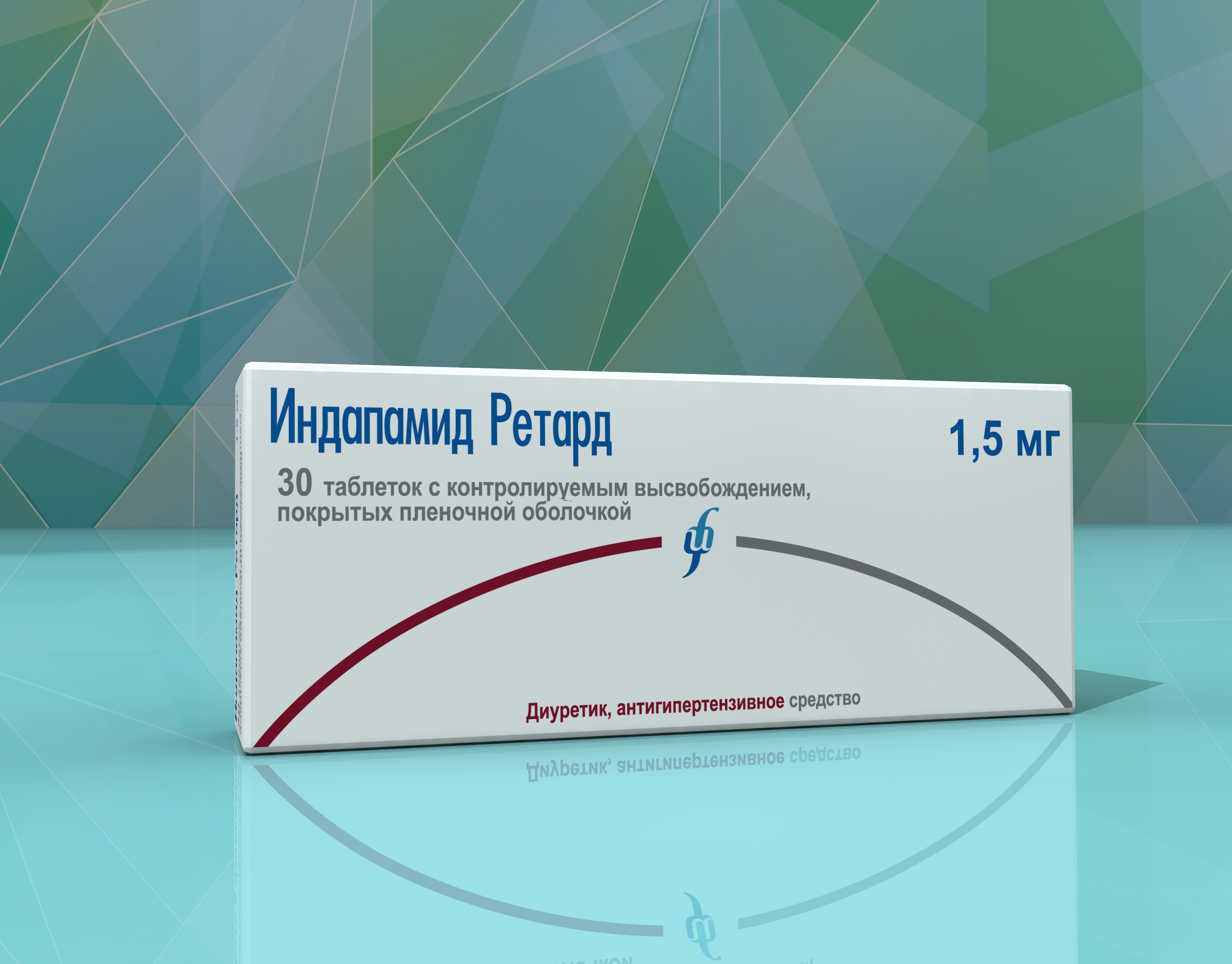
1 prolonged-release film-coated tablet contains:
Active substance: indapamide. - 1.5 mg.
Prolonged-release film-coated tablets, 1.5 mg.
10 or 15 tablets in a blister of PVC film and aluminum printed glazed foil.
2, 3, 4, 5, 6, 7, 8, or 9 blisters of 10 tablets each, or 2, 4, or 6 blisters of 15 tablets each, together with patient leaflets, are placed in a carton pack.
Arterial hypertension
Orally, 1 tablet per 24 hours, in the morning.
The tablet should be swallowed with sufficient amount of water. The tablets must not be crushed or chewed.
If the response is not satisfactory in 4-8 weeks, adding a medicinal product with an action mechanism other than diuretic should be considered (dose increase is not recommended due to stronger diuretic effect and increasing risk of side effects without stronger antihypertensive effect).
In elderly patients plasma creatinine threshold levels varies in relation to age, body weight and gender. Elderly patients can be treated with Indapamide Retard when renal function is normal or only minimally impaired.

1 film-coated tablet contains:
clopidogrel hydrosulfate -
97.87 mg (equivalent to clopidogrel - 75.0 mg)
Film-coated tablets, 75 mg. 10 or 14 tablets in a blister.
1, 2, 3, 4, 5, 6, 9, or 10 blisters of 10 tablets each, or 1, 2, 3, 4, 5, or 6 blisters of 14 tablets each, together with patient leaflets, are placed in a carton pack.
Prevention of atherothrombotic events:
• in patients with myocardial infarction (from a few days to 35 days), ischemic stroke (from 7 days to 6 months) or established peripheral arterial occlusive disease.
• in patients with acute coronary syndrome:
- without ST segment elevation (unstable angina or non-Q-wave myocardial infarction), including those who were managed with stenting during percutaneous coronary intervention (in combination with acetylsalicylic acid);
- with ST-segment elevation (acute myocardial infarction) with medical treatment and the possibility of thrombolysis (in combination with acetylsalicylic acid).
Prevention of atherothrombotic and thromboembolic complications, including stroke, with atrial fibrillation (atrial fibrillation)
In patients with atrial fibrillation who have at least one risk factor for vascular events, who are not suitable for treatment with an indirect anticoagulant and who have a low risk of bleeding (in combination with ASA).
Oral, regardless of the meal.
Patients with normal CYP2C19 function
Myocardial infarction, ischemic stroke or established peripheral arterial occlusive disease.
1 film-coated tablet (75 mg) once daily.
In patients with myocardial infarction (MI) the treatment can be started from the first days until day 35 of IM, and in patients with ischemic stroke (IS) - within 7 days to 6 months after IS.
Non-ST-segment elevation acute coronary syndrome (unstable angina, non-Q-wave myocardial infarction)
Clopidogrel should be initiated with a 300 mg loading dose and then continued
at 75 mg once a day (in combination with ASA doses of 75-325 mg daily). Since higher doses of ASA increase the risk of bleeding, the recommended ASA dose for this indication should not be greater than 100 mg. The appropriate duration of treatment for this indication is not formally determined. Clinical studies confirm that the treatment should last up to 12 months after the development of acute coronary syndrome without ST segment elevation. The maximum favorable effect was observed by the third month of treatment.
Acute coronary syndrome with ST-segment elevation (acute myocardial infarction with ST-segment elevation)
The recommended dose of clopidogrel is 75 mg once daily initiated with a single loading dose clopidogrel of 300 mg in combination with ASA, with or without thrombolytics. In patients of 75 years and older clopidogrel should be initiated without a loading dose. The combination therapy should be started fastest possible of symptoms onset and should be continued for at least four weeks. The effectiveness of combination therapy with clopidogrel and acetylsalicylic acid above 4 weeks has not been studies in this indication.
Atrial fibrillation
The recommended dose of clopidogrel is 75 mg once daily. ASA (75-100 mg/daily)
should be started and then continued with clopidogrel.
Missed dose
• If less than 12 hours passed after missed dose, it should be taken immediately, the next doses to be taken as scheduled.
• If more than 12 hours passed after missed dose, the patient should take the next dose as scheduled (Double doses should not be taken).
Patients with genetically lower activity of CYP2C19
CYP2C19 poor metabolizer status is associated with diminished antiplatelet response to clopidogrel. A higher dose regimen (600 mg as loading dose followed by 150 mg once daily) in poor metabolizer patients increases antiplatelet response of clopidogrel (see section ‘Pharmacokinetics’). Though, an appropriate dose regimen for patients with low CYP2C19 activity has not been established in clinical trials.
Special Populations
Elderly Patients
Dose adjustment is not required.
Pediatric Patients
There is no therapeutic experience in pediatric patients.
Patients with Renal Impairment
After repeat doses of 75 mg per day in subjects with severe renal impairment (creatinine clearance from 5-15 ml/min) the inhibition of ADP-induced platelet aggregation (25%) was lower than in healthy subjects, though, the prolongation in bleeding time was similar to healthy volunteers who received 75 mg daily doses of clopidogrel. Apart of this, the product was well tolerated in all patients.
Patients with Hepatic Impairment
After repeated doses of clopidogrel 75 mg/day for 10 days
in patients with severe hepatic impairment the inhibition of ADP-induced platelet aggregation was similar to healthy volunteers. The mean bleeding time prolongation was also similar in the two groups.
Ethnicity
The prevalence of CYP2C19 alleles that result in intermediate and poor metabolism of clopidogrel to its active metabolite differs according to ethnicity (see section ‘Pharmacogenetics’). There are only limited literature data for Asian populations to assess the clinical implication of genotyping of CYP2C19 on predicting ischemic complications.
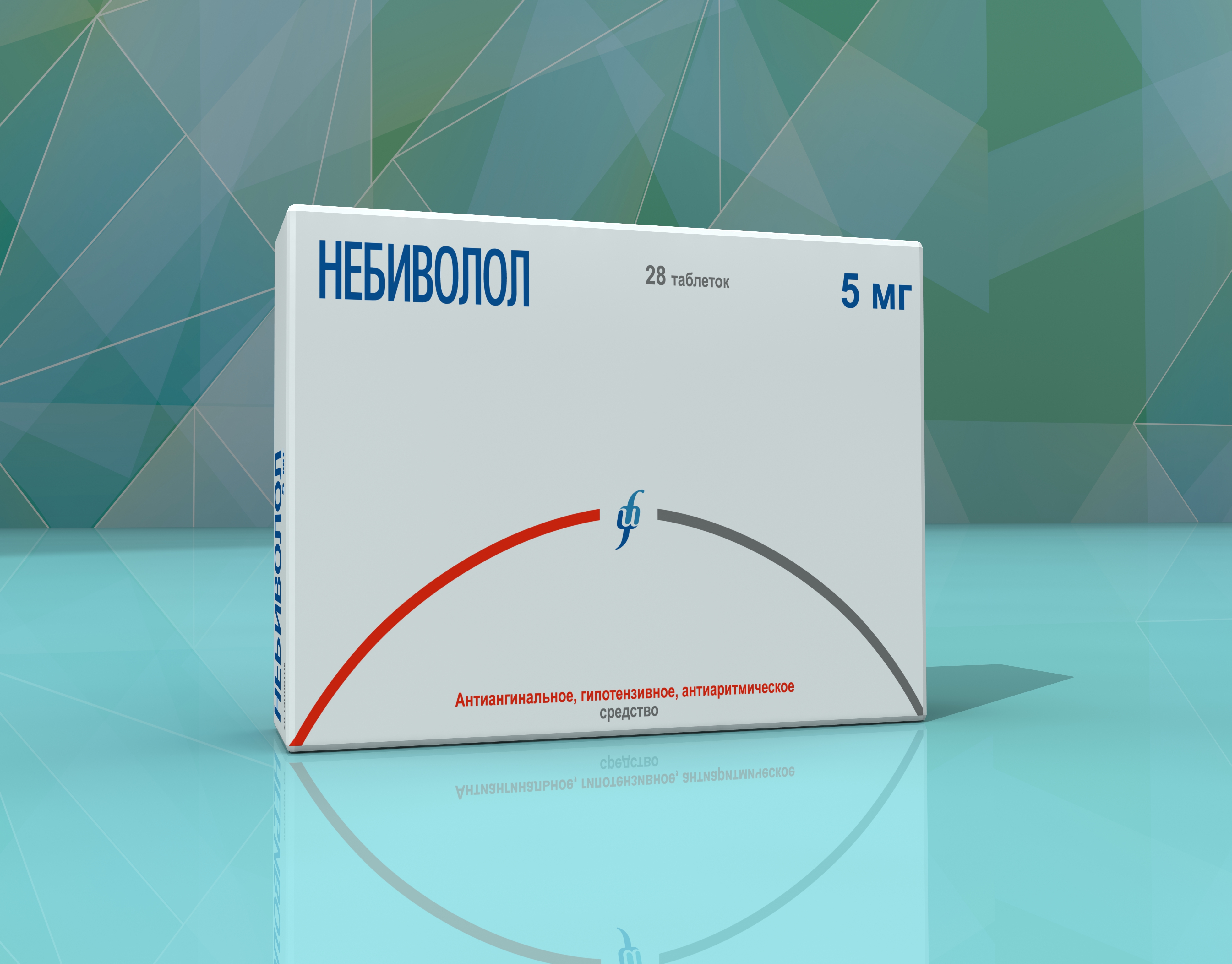
1 tablet contains:
nebivolol hydrochloride – 5.45 mg (equivalent to nebivolol –
5,00 mg).
Tablets 5 mg. 10 or 14 tablets in a blister of polyvinyl chloride film and aluminum printed glazed foil.
1, 2 or 3 blisters with patient leaflets are placed in a carton pack.
• arterial hypertension;
• coronary heart disease: prevention of exertional angina attacks;
• chronic heart failure (in combination therapy).
Oral, preferably at the same time of the day, regardless of the meal, without chewing, with sufficient amount of water.
Arterial hypertension and coronary heart disease
The average daily dose of nebivolol is 2.5 5 mg once daily. In patients with renal impairment and those above 65 years of age the recommended daily dose of nebivolol is 2.5 mg.
Where necessary the dose of nebivolol can be increased to 10 mg once daily. The appropriate therapeutic effect is visible in 1-2 weeks of treatment and in some cases in 4 weeks. Nebivolol can be used in combination with other drugs reducing blood pressure.
Chronic Heart Failure
The dose of nebivolol is titrated gradually to an appropriate individual maintenance dose. Treatment of chronic heart failure with β-adrenoreceptor blockers should be started in a clinically stable condition over the last two weeks.
The starting dose is 1.25 mg once daily gradually titrated up (at two-week intervals maximum) to 2.5 5 mg once daily, where necessary to the maximum dose of 10 mg once daily. The patient should remain under medical supervision for 2 hours after the first dose as well as after every further dose increase. During dose and regimen adjustment, if the course of chronic heart failure worsens or if not tolerated the dose of nebivolol treatment should be continued at lower doses or stopped. The treatment should not be discontinued abruptly (if not clinically necessary), because it may lead to temporary exacerbation of heart failure symptoms. If necessary, the therapy should be discontinued by gradual weekly halving the dose .
Patients with Renal Impairment (CC below 20 ml/min)
The initial daily dose is 2.5 mg. Where necessary the daily dose can be increased to 5 mg. In patients with renal impairment (CC below 20 ml/min) to dose should be increased with special caution.
Elderly Patients
For patients of 65 years of age and more the initial daily dose is 2.5 mg. Where necessary the daily dose can be increased to 5 mg. Based on the limited therapeutic experience in elderly patients, cautions should be exercised and patients above 65 years of age should be carefully examined. In elderly patients dose adjustment is not required that is why the dose should be individualized by gradual titration to a maximum tolerated dose.
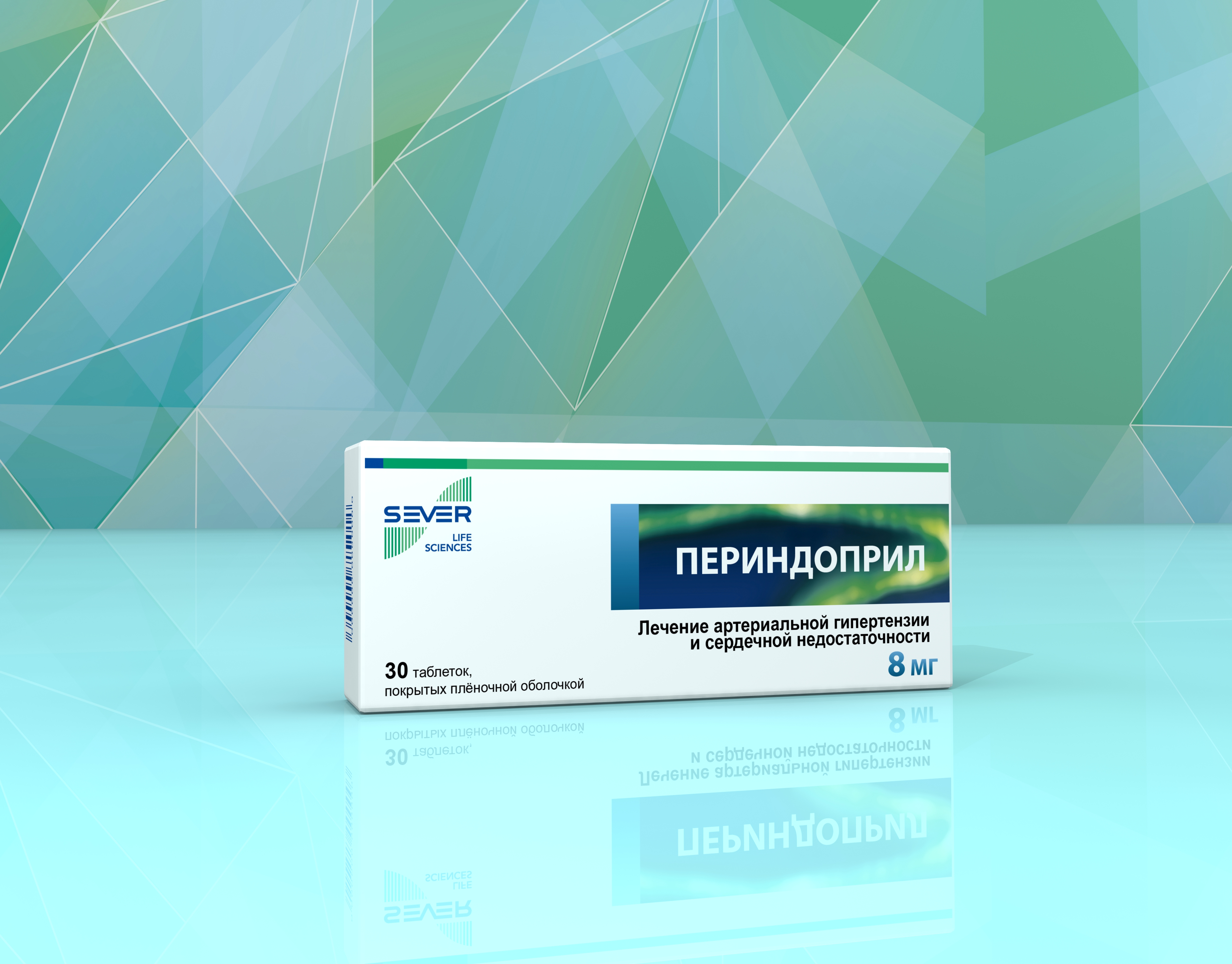
1 film-coated tablet 2 mg contains:
perindopril erbumine - 2.0 mg.
1 film-coated tablet 4 mg contains:
perindopril erbumine - 4.0 mg.
1 film-coated tablet 8 mg contains:
perindopril erbumine - 8.0 mg.
Film-coated tablets, 2 mg, 4 mg, 8 mg. 10 tablets in a blister of polyvinyl chloride film and aluminum foil.
1, 2, 3, 5, 6, or 9 blisters with patient leaflets are placed in a carton pack.
• arterial hypertension;
• chronic heart failure;
• prevention of recurrent stroke (as combination therapy with indapamide) in patients who have had stroke or transient ischemic attack;
• stable coronary heart disease (CHD): reduction of risk of cardiovascular complications in patients with post-myocardial infarction and/or coronary revascularization.
Oral, once a day, before meal, preferably in the morning.
The dosage must be individualized for each patient based on severity of disease and individual reactions.
Arterial hypertension
Perindopril can be used as monotherapy and in combination with other hypotensive drugs.
The recommended initial dose is 4 mg once daily in the morning.
For patients with evident activation of renin-angiotensin-aldosterone system (RAAS) (for example, in renovascular hypertension, fluid volume and/or salt depletion, decompensation of HCF or severe arterial hypertension) the recommended initial dose is 2 mg once daily. If therapy efficiency is not achieved during a month the dose can be increased to 8 mg once daily and the previous dose is well tolerated.
The use of ACE inhibitors in patients receiving diuretics may lead to arterial hypotension. Therefore, therapy should be conducted with caution, diuretics should be discontinued 2-3 days before the start of perindopril or perindopril should be started at 2 mg once daily. Monitoring needed: Blood pressure, renal function, serum potassium. Further dose increase depends on BP dynamics. Where necessary, diuretic therapy may be resumed.
In elderly patients the recommended initial daily dose is
2 mg in one dose. Then the dose can be gradually increased to 4 mg and, if necessary, to the maximum 8 mg once daily if the lower dose is well tolerated.
Chronic Heart Failure
The recommended initial dose is 2 mg taken in the morning under medical supervision. In 2 weeks the dosage may be increased to 4 mg daily taken in one dose with BP monitoring. In clinically significant CHF the treatment is generally combined with non-potassium-sparing diuretics, beta adrenergic blocking drugs and/or digoxin.
In CHF patients with renal impairment and ones tending to electrolyte imbalance (hyponatremia) as well as in patients receiving adjunctive therapy with diuretics and/or vasodilators, perindopril should be started under careful medical supervision.
In patients at high risk of clinically significant arterial hypotension (for example ones receiving high doses of diuretics) volume and/or salt depletion and electrolyte imbalance should be corrected before initiation of therapy with perindopril, where possible. It is recommended that BP, renal function and serum potassium concentrations should be carefully monitored before and during treatment.
Prevention of recurrent stroke in patients who have had a cerebrovascular disease
Perindopril should be started at 2 mg once daily during the first 2 weeks before indapamide administration, then the dose can be increased to 4 mg daily. The treatment should be started at any time (from 2 weeks to several years) after stroke.
Stable coronary heart disease (CHD)
In patients with stable CHD the recommended initial dose of perindopril is
4 mg once daily. In 2 weeks the dose should be increased to 8 mg daily if the daily dose of 4 mg is tolerated and renal function is monitored.
In elderly patients, treatment should be started from the dose of 2 mg which can be increased to 4 mg once daily in a week. Then, where necessary, in another week the daily dose can be increased to 8 mg subject to careful prior monitoring of renal function. In elderly patients perindopril dose can only be increased if the previous lower dose is tolerated.
In renal impairment: in patients with renal disorders perindopril dose should be individualized to the severity of renal function disorder. Patient monitoring generally includes routine monitoring of serum potassium and creatine concentrations.
Recommended doses:
|
CC (ml/min) |
Recommended dose: |
|
≥60 ml/min |
4 mg per day |
|
Between 30 and 60 ml/min |
2 mg per day |
|
Between 15 and 30 ml/min |
2 mg every other day |
|
Hemodialysis patients *(CC <15 ml/min) |
2 mg on the day of dialysis |
*- The dialysis clearance of perindopril is 70 ml/min. Perindopril should be taken after dialysis.
In hepatic impairment: dose adjustment is not required.

1 film-coated tablet 0.625 mg + 2 mg contains:
perindopril erbumine - 2.00 mg, indapamide - 0.625 mg.
1 film-coated tablet 1.25 mg + 4 mg contains:
perindopril erbumine - 4.00 mg, indapamide - 1.25 mg.
1 film-coated tablet 2.5 mg + 8 mg contains:
perindopril erbumine - 8.00 mg, indapamide - 2.50 mg.
Film-coated tablets, 0.625 mg + 2 mg, 1.25 mg + 4 mg, 2.5 mg + 8 mg.
10 tablets in a blister of polyvinyl chloride film and aluminum printed glazed foil.
1, 3, 6 or 9 blisters with patient leaflets are placed in a carton pack.
Essential hypertension (for those who need combination therapy with per perindopril and indapamide).
Once daily, preferably in the morning before a meal with sufficient amount of water.
The doses are given for the indapamide/perindopril combination.
The initial dose of Perindopril PLUS Indapamide is 0.625 mg/2 mg (1 tablet)
Once daily. If adequate BP control has not been achieved in 1 month, the dose should be increased to 1.25/4mg (1 tablet) once daily.
Dosage adjustment in patients with renal insufficiency (CC >60 ml/min) is not required. For patients with CC 30-60 ml/min the maximum dose of Perindopril PLUS Indapamide is 0.625 mg/2 mg (1 tablet) once a day the initial therapy should be started by titration of perindopril and indapamide in monotherapy. In CC below
30 ml/min usage of Perindopril PLUS Indapamide is not recommended (see section ‘Contraindications’).
In patients with moderate hepatic impairment dose adjustment is not required. In patients with severe hepatic impairment usage of Perindopril PLUS Indapamide is not recommended (see section ‘Contraindications’).
In elderly patients the initial dose of Perindopril PLUS Indapamide is 0.625 mg/ 2 mg (1 tablet) once daily.
In elderly patients before initiation of treatment with Perindopril PLUS Indapamide renal function and serum potassium should be assessed. Perindopril PLUS Indapamide initial dose is adjusted to blood pressure response, especially in total blood volume reduction and in congestive heart failure (NYHA Class IV). Such measures permit to avoid a sharp decrease in blood pressure.
The risk of arterial hypotension exists in all patients, though special cautions should be taken in administration of Perindopril PLUS Indapamide in patients with CHD and cerebrovascular insufficiency. In these patients treatment should be initiated at the dose of 0.625 mg/ 2 mg (initial dose).
In patients with established or suspected renal artery stenosis Perindopril PLUS Indapamide should be initiated in hospital environment at a dose of 0.625 mg/ 2 mg under monitoring of renal function and plasma potassium. Some patients may develop acute renal insufficiency may occur which is reversible after discontinuation of the drug.
In patients with congestive heart failure (NYHA Class IV) Perindopril PLUS Indapamide should be started at the initial dose of 0.625 mg/ 2 mg under medical supervision.
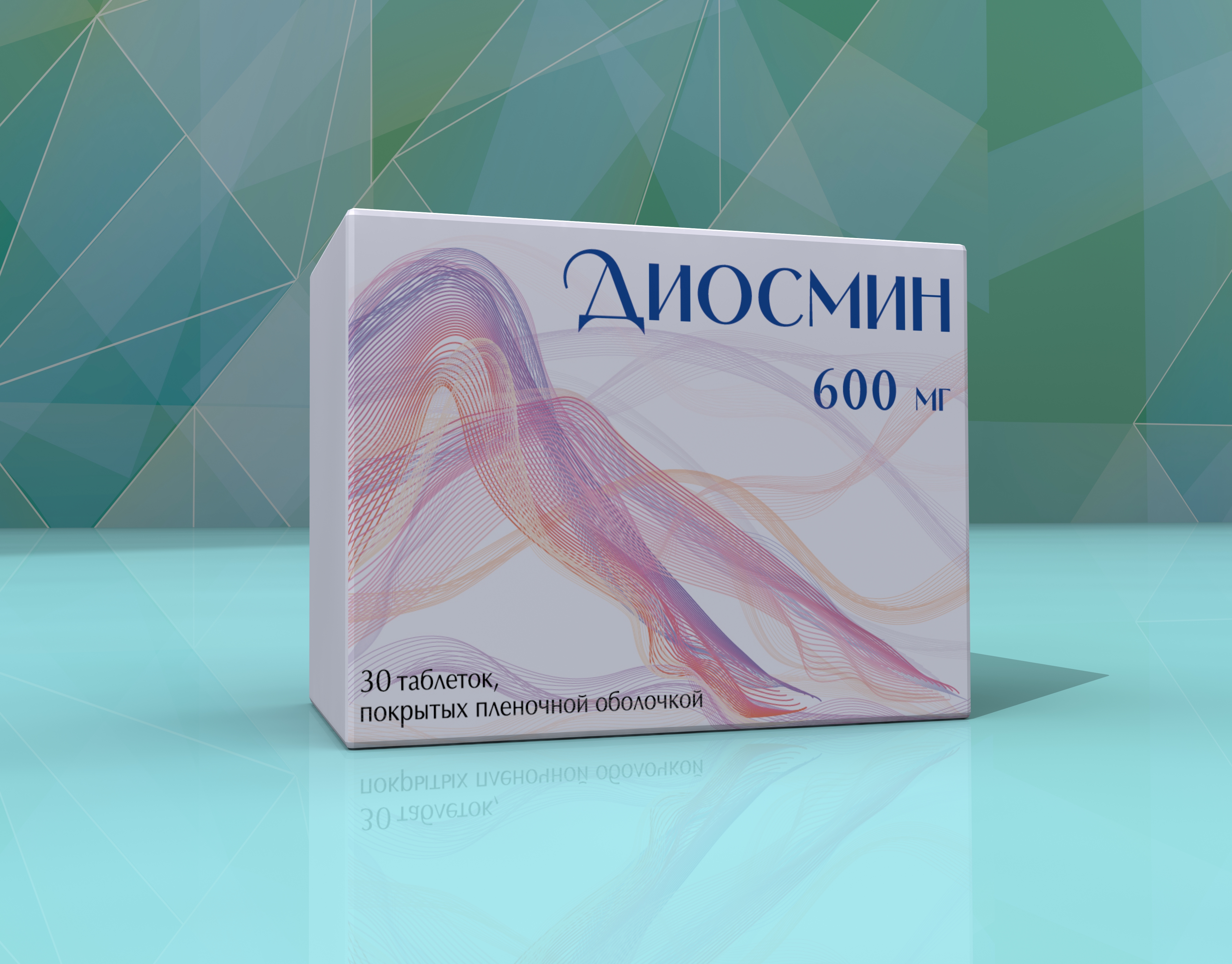
1 film-coated tablet contains:
diosmin – 600.0 mg.
Film-coated tablets, 600 mg.
10 or 15 tablets in a blister of PVC film and aluminum printed glazed foil or 30 or 60 tablets in a bottle sealed with a tamper-evident or ordinary polyethylene cap.
1 bottle or 1, 2 or 3 blisters with patient leaflets are placed in a carton pack.
Treatment of symptoms related to venolymphatic insufficiency (feeling of heaviness, fatigue, fullness in legs, pain aggravated by the end of the day, swelling).
Treatment of symptoms related to acute hemorrhoidal attack.
Additional treatment in microcirculation disorders.
The product should be taken orally.
Venolymphatic insufficiency of lower limbs
In chronic venolymphatic insufficiency the recommended dose is 1 tablet per day in the morning, preferably before a meal. The duration of treatment is generally 2 months.
Acute hemorrhoidal attack and exacerbation of chronic hemorrhoid
In acute hemorrhoidal attack and exacerbation of chronic hemorrhoid 1 tablet of Diosmin should be taken 3 times daily with a meal during the first four days, during the following 3 days - 1 tablet
twice daily with a meal. In case of symptoms recurrence the treatment can be repeated as indicated by the physician.
Chronic hemorrhoid
When acute events have been relieved the treatment should be continued at
1 tablet once daily during 1-2 months. If one or several doses are missed the treatment with Diosmin should be resumed as scheduled in the prescribed dose.
Consult your physician before using the drug.
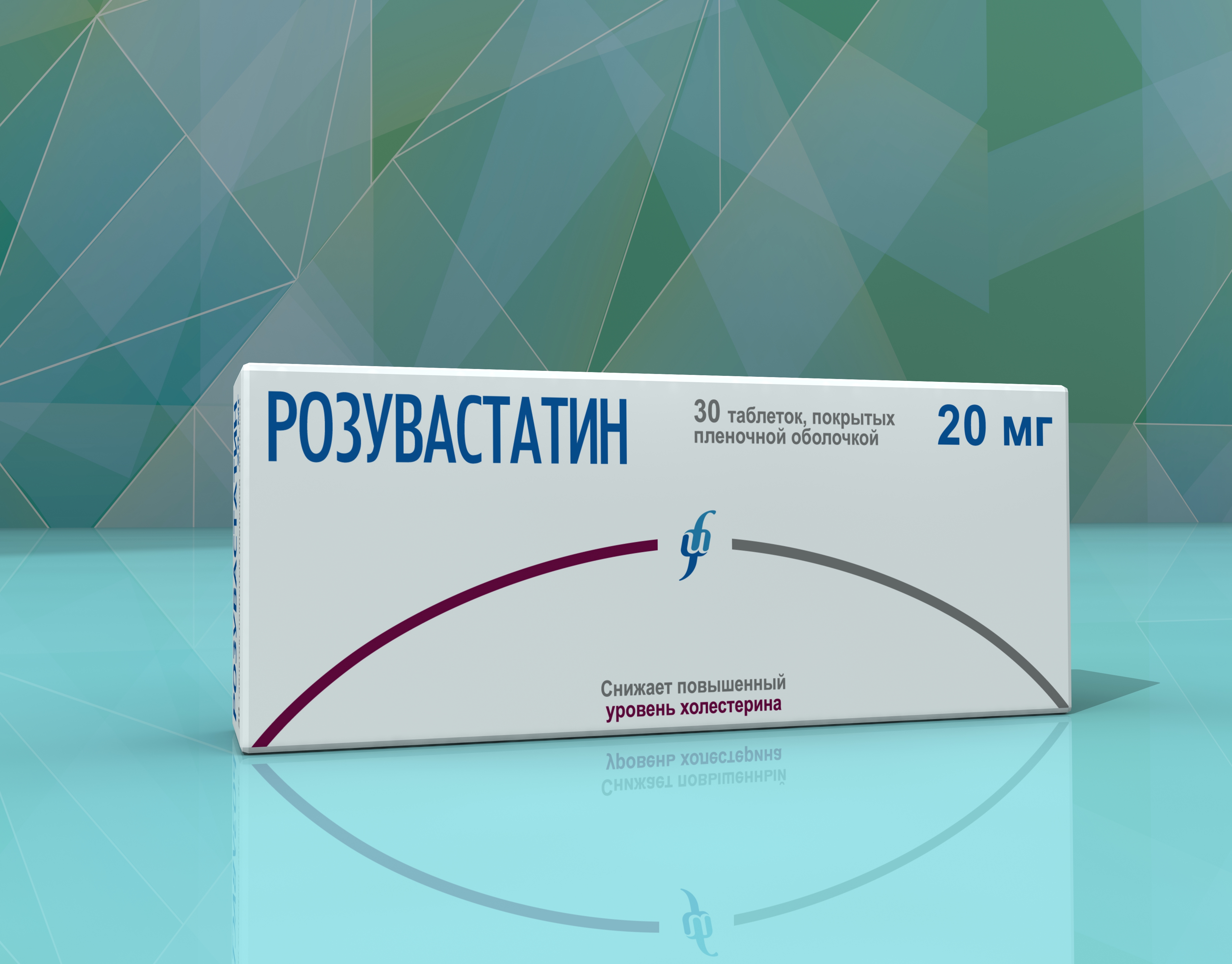
1 film-coated tablet 10 mg contains:
rosuvastatin calcium - 10.400 mg equivalent to rosuvastatin - 10.000 mg.
1 film-coated tablet 20 mg contains:
rosuvastatin calcium - 20.800 mg equivalent to rosuvastatin - 20.000 mg.
1 film-coated tablet 40 mg contains:
rosuvastatin calcium - 41.600 mg equivalent to rosuvastatin - 40.000 mg.
Film-coated tablets, 10 mg, 20 mg, 40 mg. 10, 14 or 15 tablet in a blister of polyvinyl chloride film and aluminum foil.
1, 2, 3, 4, 5, 6, 8, or 9 blisters with patient leaflets are placed in a carton pack.
• Primary hypercholesterolemia according to Frederickson (Type IIa including familial heterozygous hypercholesterolemia) or combined hypercholesterolemia (Type IIb) as an adjunct to diet when response to diet and other non-medical methods (for example, exercise, body weight reduction) has been inadequate;
• Familial homozygous hypercholesterolemia as an adjunct to diet and other lipid lowering treatments (for example as LDL-apheresis) or when this treatment is not sufficiently effective;
• Hypertriglyceridemia (Frederickson Type IV) as an adjunct to diet;
• To slow down the progression of atherosclerosis as an adjunct to diet in patients who require therapy to reduce Total-С and LDL-C concentrations;
• Primary prevention of major cardiovascular events (stroke, myocardial infarction, arterial revascularization) in adult patients without clinically significant CHD but with risk factors (age of 50 years and more for males and age of 60 years and more for females, high C-reactive protein concentration (>2mg/ml) or at least one additional risk factor such as arterial hypertension, low HDL-C, smoking, family history of early CHD).
Oral, without chewing or crushing the tablet, swallowed whole with water. The product can be taken any time of the day with or without food. Patients should be placed on a standard cholesterol-lowering diet before receiving Rosuvastatin and should continue on this diet during treatment. The dose should be individualized to the goal of therapy and therapeutic response taking into account modern general recommendations on target lipids concentrations.
The recommended initial dose for those who start the treatment and those who are switched to Rosuvastatin from treatment with another HMG-CoA reductase inhibitor should be 5 mg or 10 mg of rosuvastatin once daily. The initial dosage should be individualized with according to baseline cholesterol, with respect to possible risk for cardiovascular complications, and potential risk of side effects should also be taken into account. If necessary, the dose may be increased in 4 weeks.
Due to the risk of side effects at the dose of 40 mg as compared to lower doses, the dose of 40 mg after additional administration of a dose higher than the recommended initial dose within 4 weeks of treatment should only be used in patents with severe hypercholesterolemia and high risk of cardiovascular complications (especially in patients with familial hypercholesterolemia) who do not achieve the desired effect on 20 mg and who will be under medical supervision. Patients receiving rosuvastatin at 40 mg should be carefully monitored.
The dose of 40 mg should not be prescribed to those who have not consulted a specialist. In 2-4 weeks of therapy or/and during titration of rosuvastatin lipid metabolism should be monitored (the dose should be adjusted if needed).
In elderly patients dose adjustment is not required.
In patients with mild and moderate renal insufficiency dose adjustment is not required. In patients with severe renal insufficiency (CC <30 ml/min) rosuvastatin is not recommended. The dose of 40 mg should not be used in patients with moderate renal impairment (CC 30-60 ml/min). In patients with moderate renal impairment the recommended initial dose is 5 mg.
Hepatic Impairment: rosuvastatin is contraindicated in patients with active liver disease.
Special Populations. Ethnicity. A population pharmacokinetic analysis of rosuvastatin revealed an elevation in rosuvastatin concentrations in Asian subjects. This fact should be considered in usage of rosuvastatin in this population. For doses of 10 mg and 20 mg, the recommended initial dose for Asian patients is 5 mg. The dose of 40 mg should not be used in Asian patients (see section ‘Contraindications’).
Genetic Polymorphisms. In patients with SLCO1B1 (OATP1B1) c.521CC and ABCG2 (BCRP) c.421AA genetic polymorphisms there is a risk of increased rosuvastatin AUC as compared the SLCO1B1 c.521TT or ABCG2 c.421CC genotypes. For patients with c.521CC and c.421AA genotypes the maximum dose of rosuvastatin is 20 mg once daily (see sections ‘Pharmacokinetics’, ‘Warning and Precautions’ and ‘Drug Interactions’).
Patients predisposed to myopathy. Rosuvastatin 40 mg is contraindicated in patients with pre-disposing factors for myopathy (see section ‘Contraindications’). For doses of 10 mg and 20 mg, the recommended initial dose in this group of patients is 5 mg (see section ‘Contraindications’).
Concomitant therapy. Rosuvastatin is a substrate of various transporter proteins (in particular, OATP1B1 and BCRP). The risk of myopathy (including rhabdomyolysis) is increased when rosuvastatin is administered concomitantly with certain medicines that may increase the plasma concentration of rosuvastatin due to interactions with these transporter proteins (e.g. cyclosporine and certain HIV protease inhibitors including combinations of ritonavir with atazanavir, lopinavir, and/or tipranavir) ( see sections ‘Warning and Precautions’ and ‘Drug Interactions’). In these cases alternative medications or temporarily discontinuing rosuvastatin therapy should be considered. In situations where co-administration of these medicines is unavoidable, the benefit and the risk of concomitant treatment with rosuvastatin and dosing adjustments should be carefully considered (see section ‘Drug Interactions’).
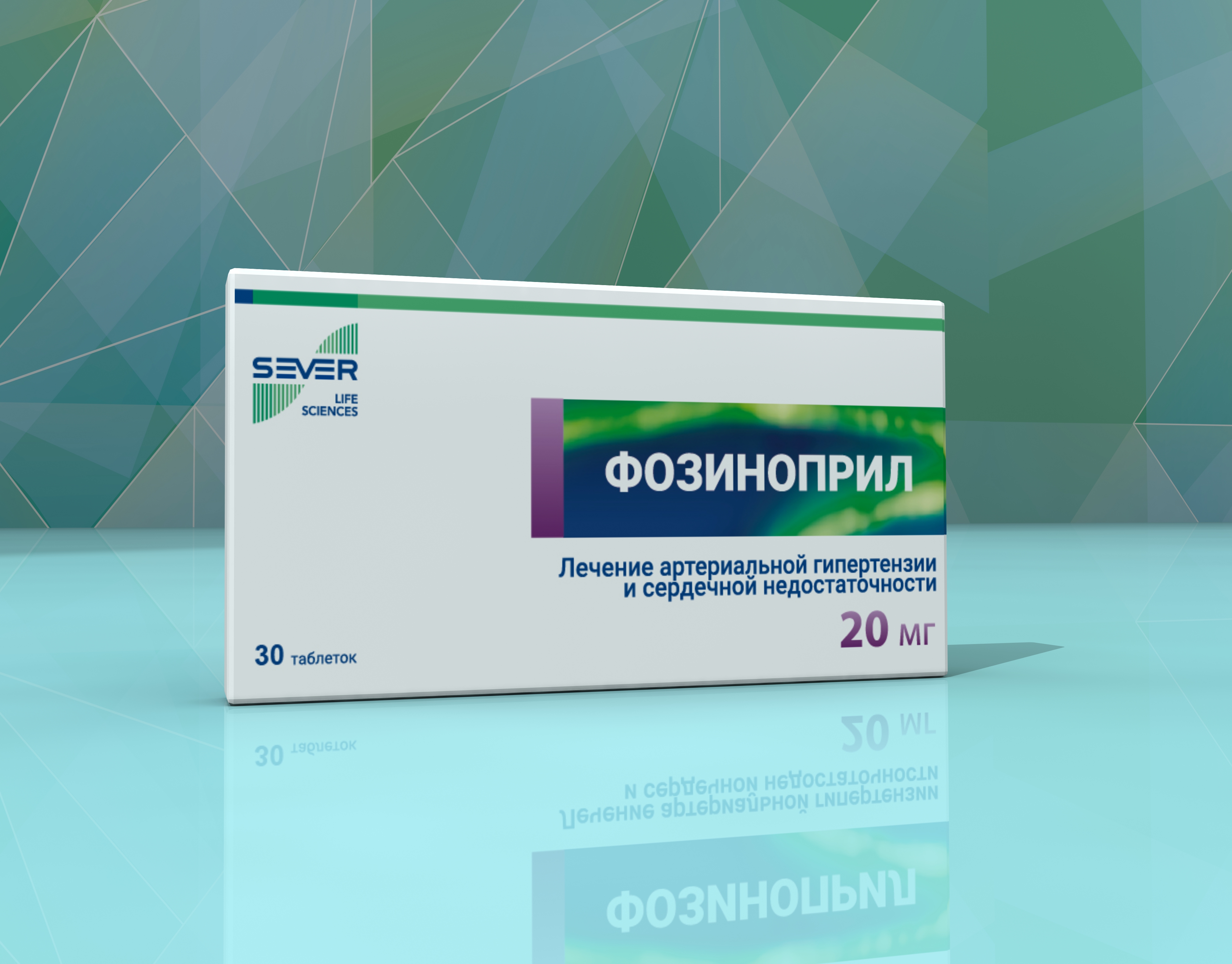
1 tablet 10 mg contains:
fosinopril sodium – 10.00 mg.
1 tablet 20 mg contains:
fosinopril sodium – 20.00 mg.
Tablets 10 mg, 20 mg. 10 or 15 tablets in a blister of PVC film and aluminum printed glazed foil.
1, 2, 3, 5, 6 or 9 blisters of 10 tablets each or 2, 4 or
6 blisters of 15 tablets each with patient leaflets are placed in a carton pack.
• Arterial hypertension - in monotherapy or in combination therapy with other antihypertensive drugs (in particular, thiazide diuretics)
• Chronic heart failure - in combination therapy.
Oral. The dosage should be individualized.
Arterial hypertension
The recommended initial dose of Fosinopril is 10 mg once daily. Dosage should be adjusted according to blood pressure response. The usual dose is from 10 mg to 40 mg once daily. If adequate antihypertensive effect has not been achieved a diuretic may be added.
If Fosinopril is started in those who are currently treated with diuretics, the initial dose should not exceed 10 mg subject to careful medical supervision.
Chronic Heart Failure
The recommended initial dose is 5 mg (½ tablet of 10 mg) once or twice daily. Based on therapeutic response the dose can be titrated over a week to the maximum dose of 40 mg once daily.
Arterial hypertension and heart failure in renal and hepatic impairment
Since the drug is eliminated from the organism in two ways, dose reduction in patients with renal and hepatic impairment is not required.
Geriatric patients
There is no difference in effectiveness and safety of fosinopril in elderly patients of 65 years and older and younger patients. However, greater sensitivity of some older individuals cannot be ruled out due to risk of overdose effects.
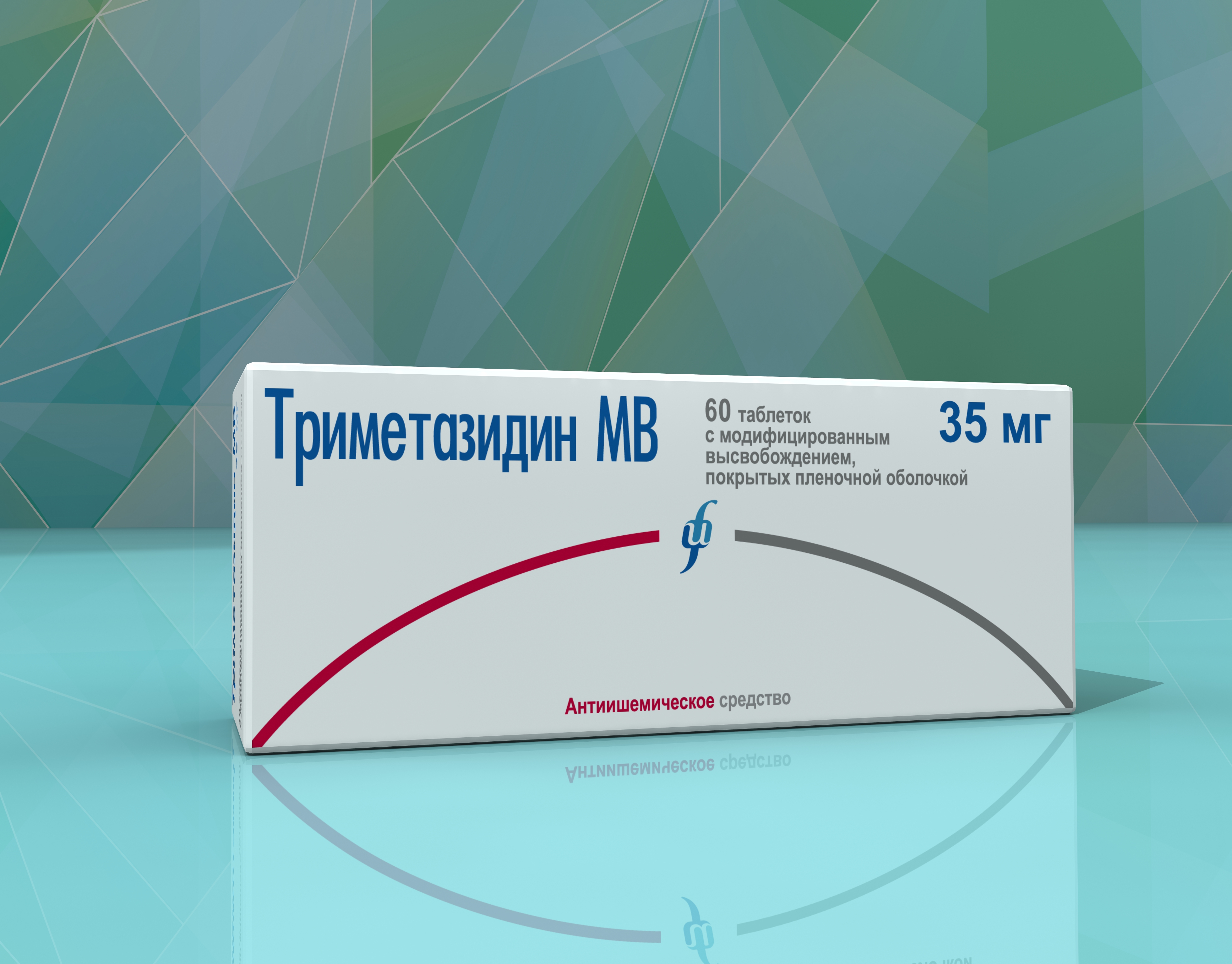
1 prolonged-release film-coated tablet contains:
trimetazidine dihydrochloride – 35.0 mg
Prolonged-release film-coated tablets, 35 mg.
10 tablets in a blister of PVC film and aluminum printed glazed foil.
1, 3, 6, 12 or 18 blisters with patient leaflets are placed in a carton pack.
Long-term therapy of coronary heart disease: prevention of attacks of stable angina as monotherapy or in combination.
Tablets should be swallowed whole without chewing with water.
Orally, 1 tablet twice daily in the morning and in the evening with a meal.
The duration of treatment should be determined by the specialist.
The maximum daily dose is 70 mg.
Special populations
Patients with Renal Impairment
In patients with moderate renal impairment
(CC 30-60 ml/min) the daily dose is 35 mg (1 tablet) in the morning during breakfast.
Patents aged 75 and more
Patents aged 75 and more may have increased trimetazidine exposure due to age-related decrease in renal function (see section ‘Pharmacokinetics’). In patients with moderate renal impairment (CC 30-60 ml/min) the daily dose is 35 mg (1 tablet) in the morning during breakfast. Dose titration in patients aged 75 and more should be exercised with caution (see section ‘Warnings and Precautions’).
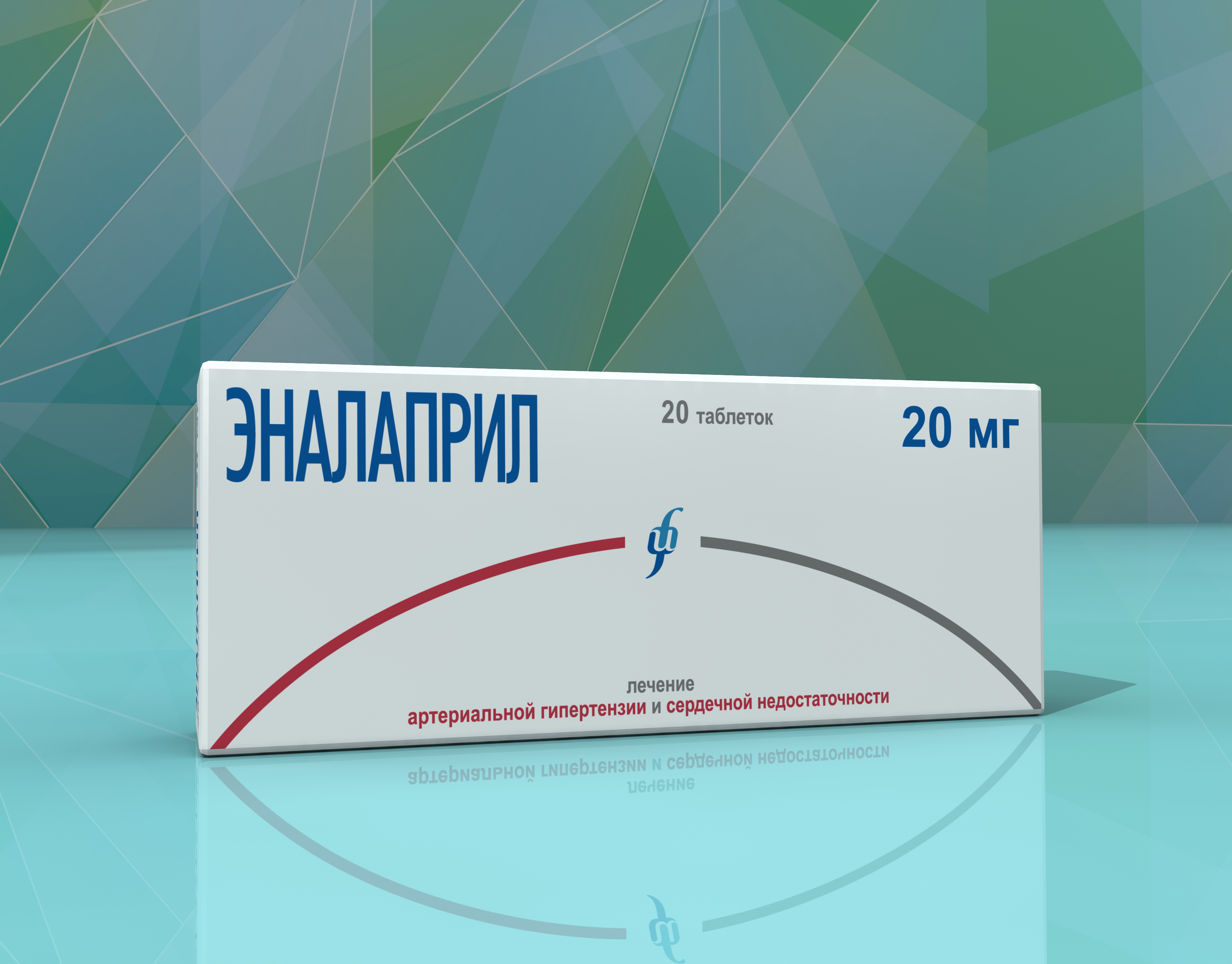
1 tablet 5 mg contains:
enalapril maleate - 5.0 mg.
1 tablet 10 mg contains:
enalapril maleate - 10.0 mg.
1 tablet 20 mg contains:
enalapril maleate - 20.0 mg.
Tablets 5 mg, 10 mg, 20 mg.
10 in a blister of polyvinyl chloride film and aluminum printed glazed foil.
1, 2, 3, 5 or 10 blisters with patient leaflets are placed in a carton pack.
• Essential hypertension of any severity.
• Renovascular hypertension.
• Heart failure of any severity.
In patients with clinically significant symptoms of heart failure enalapril is indicated to:
- increase survival;
- slow down progression of heart failure;
- decrease the frequency of hospitalization for heart failure.
• Prevention of clinically significant heart failure.
In clinically stable asymptomatic patients with left ventricular dysfunction enalapril is indicated to:
- decrease the rate of development of overt heart failure;
- decrease the frequency of hospitalization for heart failure.
• Prevention of coronary ischemia in patients with left ventricular dysfunction.
Enalapril is indicated to:
- decrease the frequency of myocardial infarction;
- decrease the frequency of hospitalization for unstable angina.
Enalapril should be taken orally, regardless of the meal. To ensure the described below dosage regimens where enalapril 2.5 mg should be used, enalapril products of other manufacturers should be prescribed in the dosage form ‘tablets 2.5 mg’ or ‘tablets 5 mg’ with a score.
Essential hypertension
The initial dose is 10-20 mg depending on the severity of arterial hypertension (AH) and should be taken once daily. In mild AH the recommended dose is 10 mg once daily. In other AH severities the initial dose is
20 mg once daily. The maintenance dose is 1 tablet 20 mg once daily. The dosage should be individualized to each patient but the maximum dose should not exceed 40 mg per day.
Renovascular hypertension
Since BP and renal function in this population may especially responsive to ACE inhibition, the therapy should be started at a low initial dose of
5 mg and lower. Then the dose should be individualized to patient’s needs and condition. Generally the efficient dose of enalapril is 20 mg taken once daily. In patients who received diuretics shortly before, should be treated with enalapril with caution (see section ‘Concomitant treatment of AH with diuretics’).
Concomitant treatment of AH with diuretics
After the first administration of enalapril symptomatic arterial hypotension may occur. This effect is most likely in patients who receive diuretics. Enalapril should to be taken with caution, as these patients may show electrolyte imbalance. Diuretics may be discontinued 2-3 days before initiation of enalapril. If this is not possible, the initial dose of enalapril should be decreased (to 5 mg) in order to determine the initial BP response. The dosage should be individualized to patient’s needs and condition.
Dosage in Renal Impairment
Intervals between enalapril administrations should be increased and/or the dose should be reduced.
|
Creatinine clearance, (ml/min) |
Initial dose, mg/day |
|
< 80 ml/min > 30 ml/min |
5-10 mg |
|
< 30 ml/min > 10 ml/min |
2.5-5 mg |
|
< 10 ml/min |
2.5 mg (on the day of dialysis)* |
*Enalapril is dialyzable. Dosage on nondialysis days should be adjusted depending on the blood pressure response.
Heart failure / asymptomatic left ventricular dysfunction
The initial dose of enalapril in patients with clinically significant heart failure or asymptomatic left ventricular dysfunction is 2.5 mg. The product should be administered under close medical supervision to determine the initial effect on blood pressure. Enalapril may be used for the treatment of heart failure with significant clinical symptoms usually in combination with diuretics and, where necessary, with cardiac glycosides. In the absence of, or after effective management of symptomatic arterial hypotension following initiation of enalapril therapy, the dose should be increased gradually to 20 mg daily taken as either a single dose or two divided doses depending on the patient's response . The dose titration may be performed over a 2-4-week period, or more rapidly if indicated by the presence of residual signs and symptoms of heart failure. This therapeutic regimen is effective in reducing patient mortality in patients with symptomatic heart failure.
Blood pressure and renal function should be routinely monitored before and after initiation of enalapril treatment (see section ‘Warnings and Precautions’) because cases of arterial hypotension with, rarely, further renal failure have been reported. In patients receiving diuretics, the dose of diuretics, if possible, should be reduced before initiation of enalapril. Arterial hypotension after the first dose of enalapril does not mean that arterial hypotension will recur in long-term treatment and does not indicate that the treatment should be discontinued. Serum potassium should be monitored in enalapril treatment.
(see section ‘Drug Interactions’).